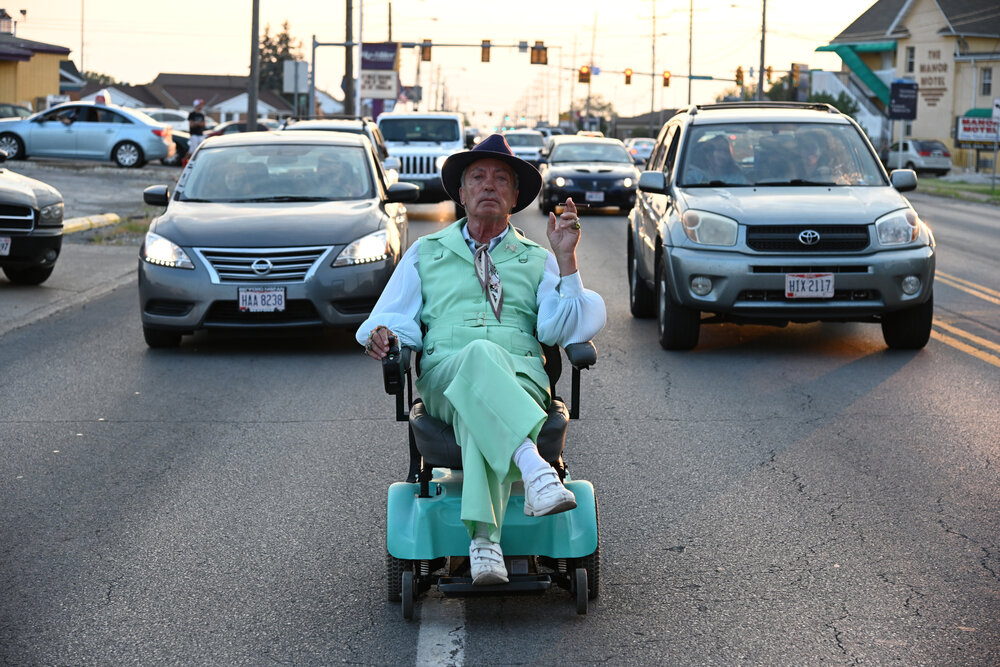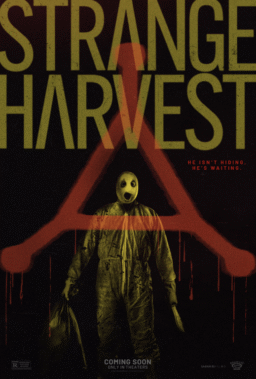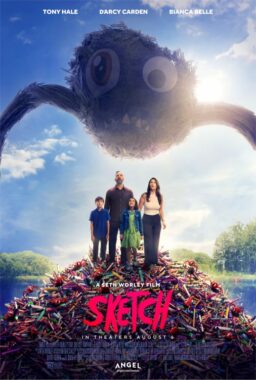Udo Kier is a living legend of cinema. Over the last 55 years, he has proved prolific and pioneering, appearing in more than 220 films and working with the likes of Lars von Trier, Gus van Sant, Dario Argento, and Andy Warhol. At the start, this German actor was proclaimed by the press as “the most beautiful boy in the world.” From there, his intense screen led to a string of horror movies, and he became a character actor who could dazzle with a few short scenes. You might recognize him in anything from the 1977 Giallo classic “Suspiria,” to the heralded 2019 thriller “Bacurau” to Pamela Anderson’s outrageous 1996 action vehicle “Barb Wire.” Kier has truly done it all … almost. At 76, Kier has at long last made the leap to leading man with “Swan Song,” an elegiac comedy that some are calling his best movie yet.
Kier stars as Mr. Pat Pitsenbarger, “the Liberace of Sandusky, Ohio.” Inspired by the real Mr. Pat, writer/director Todd Stephens creates a terrific tribute to an audacious gay hairdresser who dared to live out loud—and out of the closet—long before the world was been ready for him. “Swan Song” begins with Mr. Pat, moldering away in a retirement home in a soiled sweatsuit. His glory days seem long behind him. Then, comes an offer he cannot refuse: style the hair of the town’s most powerful socialite one last time, for her funeral. Walking into town becomes an odyssey to get the tools, face his former friends, confront the past, make amends, and go out with a bang. Of course, he’ll do it in style, trading his shabby sweats for a splendid mint-green leisure suit.
Filled with ruthless reads and tender moments, “Swan Song” is being celebrated not only for enchanting audiences but also for showcasing Kier’s incredible range. Who would have predicted it’d be a crowd-funded indie shot on-location in Ohio that would give this iconic actor such raucous acclaim? No one is more surprised or delighted than the man himself.
What attracted you to “Swan Song”?
I got the script sent by Todd Stephens and I liked the script very much. I wanted to meet him. He came to Palm Springs—that’s where I live now. So, he came down here, and we talked about the film. I liked him. If I hadn’t liked him, I wouldn’t have done the movie.
I heard you asked to shoot in chronological order. Tell me about that.
I wanted to shoot the retirement home [section] first—chronological—because I didn’t want to go in the green suit, then three days later I’m lying in bed as an old man in a retirement home. So, we did it as chronologic as much as we could. The whole film was basically—I can say—without rehearsal. We just did it, it wasn’t that kind of acting-acting.
I always remember Lars von Trier, who I’ve worked with for 30 years. I just worked with him again for a couple of weeks in “The Kingdom,” the last episode. I’ve made about 10 movies with him. When we did “Dogville,” sitting at a table was Lauren Bacall, Ben Gazzara, James Caan, Nicole Kidman, Chloë Sevigny, and Stellan Skarsgård, and Udo Kier. And Lars came into our little hotel where we were eating, and he said, “Don’t act, please.”
So, I never act in the movie. [In “Swan Song,”] I was the character of a different generation going back to a time where being so flamboyant maybe was not forbidden, but people maybe didn’t accept it like they accept it today. Today, [gay] people can hold hands at Applebee’s or McDonald’s if they want. Nobody cares. But the period when Pat lived in Sandusky was different.

For me, it was the experience from an old man living in a retirement home, gave everything up, his friend died, and the best customer died. He doesn’t want to go back there [at first]. But then he makes up his mind to go there. As seen in the film, he gets a beautiful green suit. The moment I have the green suit on, I never had another costume on the whole trip. I would only wear that because that was part of the character. It’s flamboyant like David Bowie or Sir Elton John with all his wonderful sunglasses.
I was a little bit surprised that all the critics—and very good ones—wrote this is my best film I’ve ever done. I mean, I’m doing this for 50 years, working with Gus Van Sant, Wim Wenders, Rainer Werner Fassbinder, all really amazing directors. And then I make a low-budget film with an interesting story, and everybody writes it’s my best movie. Variety says, everybody says, “It’s the best movie he’s ever done.” But one critic, Entertainment Weekly’s headline brought it to the point. He wrote: “After 50 years, Udo Kier is finally a leading man.”
That is because [in ‘Swan Song”] you meet me and you follow me. You have tears in your eyes or you laugh. And I think that is what makes this film different. I think also in all the things we’ve been through for 18 months in America and in the whole world, a film like that with a style like that, people want to see that. Yesterday, we had a screening at the university, and there were young girls. And after the Q&A, they said, “That’s one of the best films I ever have seen.” And I said, “Wow, young people liked the film.”
I really connected to it. Especially after a year where we lost Pride Month, the dance sequence in the gay bar felt really cathartic. What was it like for you, after years of being a legendary character actor, to take on the mantle of leading man?
Of course, I’m looking forward now in the future to work only in the lead part. I think all the press in America, giving me this honor of making “the best film.” I cannot disappoint them all of a sudden and be just a killer in the parking lot. No, no, no. I will try—except for friends’ [productions]—I will try to get films where I am the main character again.
“Swan Song” is all about the legacy of Mr. Pat. You have such a storied career. When you choose projects, do you think about how will this impact your legacy?
Well, yes. I mean, I get a lot of scripts and I read the scripts. First, I read my role only. And then I read the whole script with my role. And if I think, “The film is also working without me,” why should I be in the movie?
There are also some productions that want your name attached, because then they can sell the film better. That’s a normal thing, of course. But, I’m at the moment enjoying the success of “Swan Song,” and I’m having lunch in a moment and having a glass of Chardonnay, and I will have a smile on my face. It’s really wonderful.

I was very impressed with the film because it’s this love letter to a generation of gay men who dared to be out when that wasn’t just socially frowned upon, but actively dangerous. What did it mean to you to play a character like Mr. Pat, who embodies that celebration?
I had to do some research [on the real Mr. Pat]. And of course, I talked to Pat’s real friends, who are still alive, all gentlemen. And they taught me a lot. We spent an afternoon together, and they told me how he smoked, how he was holding the cigarette. They told me how he was speaking, how he was walking. They showed me some movements. And of course, they know him. They were the best friends. So, I learned like that.
So, it was important to capture for you some of the gestures of the man that “Swan Song” is based on?
Yes, definitely, because they were not mine. I knew I’m playing someone who once was alive, so of course. It was altogether a great experience, and I don’t want to miss it for nothing in the world. I did this film and I’m very happy for Todd, that he directed this film.
You spoke earlier about the green suit. I’m curious, was there any other suits that they were considering?
No, they have found that, the costume ladies (Kitty Boots and Shawna-Nova Foley) and Todd. Then, they showed it to me and I said, “No question: Yes.” And that’s why once I had that suit on, I never tried another costume on. Once I have to green suit on, I wanted to stay in that suit and not in something else, because that was part of being a figure who lives and goes back into the past. And I like it the moment in the store, he tries it on and he likes it.
It’s a wonderful scene. The first time I saw the film, I was laughing and crying when he comes out of the fitting room. I can understand why—as a performer—you don’t want to go back to the sweatsuit after that. Everything needs to move forward.
It’s good. I showed [“Swan Song”] to friends and good friends, I can trust their words, and they said, “Oh, we were crying, we were laughing.” And I said, “Well, that’s great.” I mean, because I didn’t act to make people cry or laugh. I was the person, which I found through Todd and through his friends and the city I’ve never been, so it all came together.

Did you keep the green suit?
No.
Oh, I’m surprised you gave it back.
It’s because I’m not Mr. Pat anymore. I don’t want to say to everyone, “My friends, I put it in a frame.” I have a Keith Haring jacket on my wall. It’s from Keith Haring, he did a drawing on my leather jacket.
But I don’t want a suit in a frame like Japanese people put a kimono in a frame. No. It’s done. It’s done. I made already three films after “Swan Song.” So, it’s not my swan song. And I continue trying to find a story and a leading part in a good movie.
“Swan Song” is now playing in theaters.












